#and they parasitize spider eggs
Explore tagged Tumblr posts
Text
sometimes you just gotta break down and make the damn Wikipedia page
#this is for all my enjoyers of the genus Baeus out there#I'm going to find every goddamn source i can and I'm going to give you every damn thing I've got#I'm going to learn how to format on Wikipedia from the ground up or so help me#mine#Wikipedia#listen to me. come closer#*whispers* Baeus is an extremely cute genus of parasitoid wasps#they look like roly-polys#and they parasitize spider eggs#and I LOVE THEM
2 notes
·
View notes
Text
gross thought but like what do you think would happen if taylor got a parasite. like a tapeworm. one of the ones that hatches in the human body. cause her power doesn't detect larvae or eggs i don't think so she wouldn't know about it if she drank dirty water or something.
again gross thought but i'm thinking about her like detecting through her power a tapeworm hatching in her own stomach. or intestines. wherever tapeworms live. what would you do about having a tapeworm in your stomach and knowing about it from the moment it hatches from its egg. like do you let it die? cause she controls it so she can just make it so it doesn't eat any food and it starves to death. does that make it worse does that kill you
#cw parasites#cw parasites mention#was writing a fic snippet where taylor buys food at a really shitty bar that doesn't have health and safety standards#she doesn't eat it but like. if she had eaten it what would happen#this feels like i'm talking about a sex thing. i'm not#not that there's anything wrong with that#i don't have a problem with fetishes or kinks or anything#unless you're like. giving people parasites without their knowledge. that's bad and you shouldn't do it#but anyway it's not a sex thing. see this makes it sound more like a sex thing but its not#this is just like that time i was talking about how i couldn't think of a stress response other than puking#THAT WASN'T A SEX THING EITHER#normally i would look up tapeworms to find out if they actually live in intestines or not or whether they are born from eggs#but i don't want to look it up because there will be pictures and i don't wnat to look at those. i saw a single spider today i hit my limit#very funny to me that i am a big worm fan while indeed being afraid of spiders and various bugs such as tapeworms and wasps#do you think aisha would say this to taylor#hey taylor what happens if you get a tapeworm#and taylor stares off into the middle distance wondering what she's done wrong to deserve this (there was a lot actually)#i would tag this worm or parahumans but it would maybe be better if nobody saw this methinks
17 notes
·
View notes
Text
Bad Pokémon Idea:
Bad Pokémon Idea: An early game cocoon bug-type Pokémon (like Butterfree, Beedrill, Vivillon, etc.) that’s a spider, then a paralyzed spider being devoured from the inside out by wasp larva, then a wasp
#plot twist: this is actually what happens with beedrill#beedrill just lays its eggs in a kakuna and they parasitize the weedle inside#that's going to be my headcanon from now on and no one can stop me#bad pokemon ideas#pokemon#fakemon#route 1 shitmon#spider#wasp#parasitic wasp#bug pokemon
31 notes
·
View notes
Text
Also it generally bothers me how animals must be human like in order to garner affection from most people, it's such a joke that people believe in ”speciesm" the oppression of animals because they are different from us, yet many of these same people try to paint x or y animal as valuable by comparing it to people or pointing out a trait of it that's similar to humans. Like it's beautiful how loving whale moms are to their calves like humans, yes, but is that why we should care about them? shouldn't we also care about them if they weren't loving moms? aren't they still valuable to the world even if they cannibalized their children? or do you only care about other living creatures if they are like us?
What about parasites? bloodsucking ticks? wasps that lay their eggs in dead spiders they've paralyzed, rat mothers that eat half their newborns? newborn caecillians that eat their mother's delicious skin? the earthworm that has no sense of morality, altruism, or parental love? aren't they worthy too? do they have to be like us to be loved?
4K notes
·
View notes
Note
Many parasites takeover the minds and bodies of insects, spiders or other creatures, making them like zombies. You’ve listed some in spider-ween and other places. Do you know any parasites that take over bees? I know wasps lay their eggs in their larva, but haven’t really found anything about those that pilot a bee’s body.
Strepsipterans! Also frequently just called "Stylops"
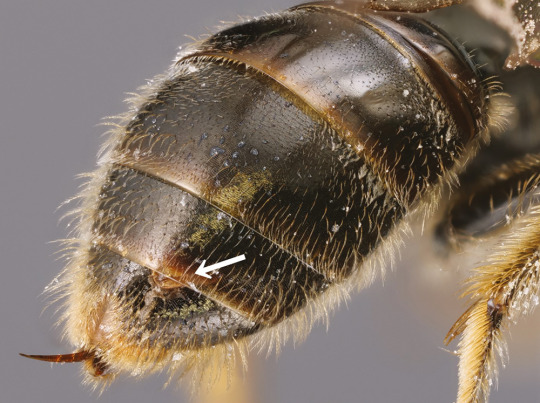
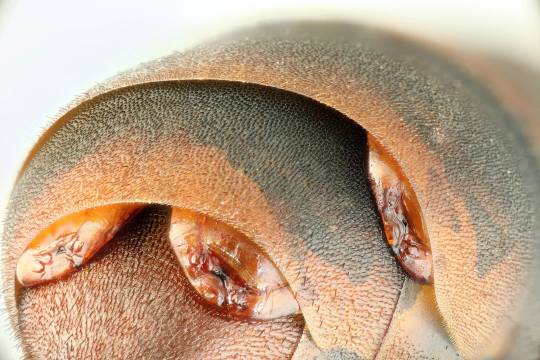
These are the weirdest most alien insect group in existence. What you're seeing are the head ends of the mature females; their bodies are just bags of tissue that absorb nutrients from the host, so they no longer have any trace of limbs or wings and their flat little heads no longer have mouths or eyes.
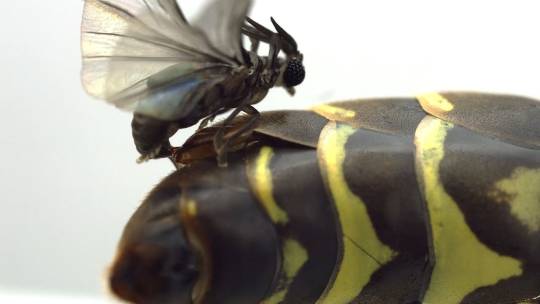
The only reason the female's heads stick out of the host at all is because the head evolved into the end they mate with. The short-lived mature male is a very tiny flying thing (whose anatomy is unlike any other insect alive today - a totally unique type of wing, unique eye arrangement, we have NO idea what these evolved from, except for some loose connections to beetles!) who mates by breaking through the female's featureless armored face with his bladed genitalia and then he dies. And Strepsiptera can be found infecting all sorts of arthropods, even apparently some arachnids, but none of those arthropods really tend to sit still when a little tiny flying man tries to land on them, so the females usually do something to their hosts (we aren't sure what exactly) to make them slower and more complacent. Social Hymenoptera like bees are especially common hosts though, and when a worker bee or wasp is infected by stylops, she actually abandons her colony and her duties for extended periods of time to just perch in one place while the parasite broadcasts its mating pheromones. This is especially eerie from the bee's perspective; a worker bee is a female bee that wasn't allowed to become a queen and isn't "supposed" to be going around mating, but now she's sitting around waiting for a male just like any other bug that wants to be a mom. It's just not a male of her species and she's not the one who gets to reproduce. Is the parasite tapping into buried queen behavior? Does the bee's little brain think it's calling for a drone to help it start a new hive? Or does the parasite just make the bee a lazy slob who stops caring about her hive and just feels like chilling out on a flower all day? We might never know.
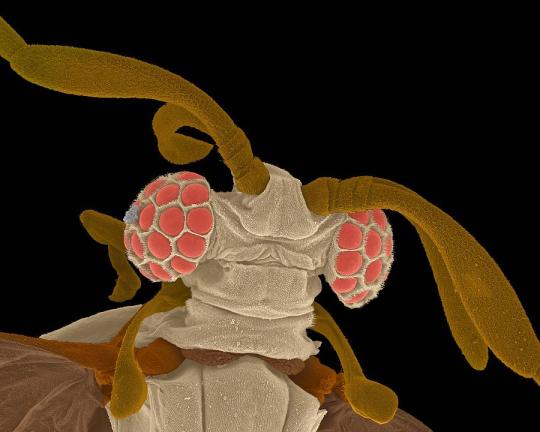
Here are those unique eyes of the male for anyone wondering. Not set in a fine multifaceted grid like in other insects, but clustered, still set in their own individual "sockets" like we see in much more ancient arthropods like trilobites! This suggests that Strepsipteran eyes date back to when insects were first beginning to evolve towards true compound eyes, but there still aren't many insects in the fossil record that have anything else in common with these animals. EDIT: oh yeah I forgot to include that these are in the children's book made by @revretch and I!
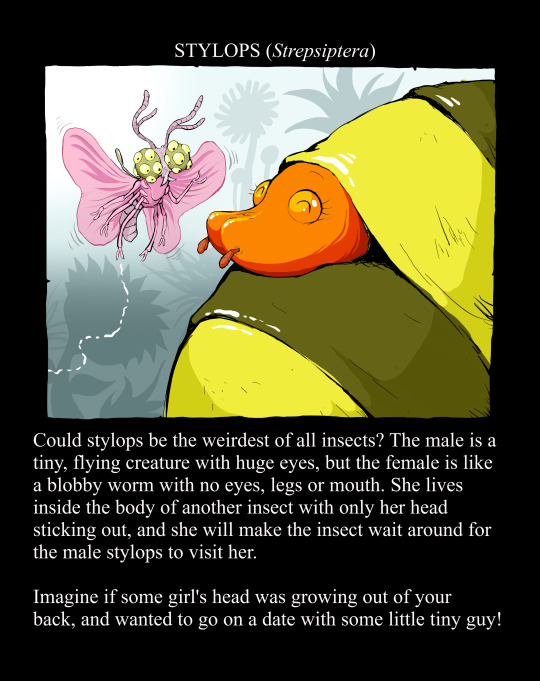
I did the rough pencil sketch of this page while Rev did the beautiful inks! I felt kids should know about these animals but I tried to explain it in the most kid-friendly way possible.
2K notes
·
View notes
Text
Round 2 - Arthropoda - Pycnogonida




(Sources - 1, 2, 3, 4)
Pycnogonida is a class containing one order: Pantopoda, which means “all feet.” A fitting name for creatures that seem to be made entirely of legs. Commonly called “Sea Spiders”, they are not spiders, nor are they arachnids, but are actually a sister group to all other living arthropods.
Pycnogonids live in most oceans. Most are tiny, living in relatively shallow water, though some can grow to be quite large in antarctic and deep waters. Some pycnogonids are so small that each of their muscles consists of a single cell. They have a proboscis which they use to suck nutrients from soft bodied invertebrates such as cnidarians, sponges, polychaetes, and bryozoans. They can also insert their proboscis into anemones, though this rarely kills the anemone. The pycnogonid digestive tract extends into their legs. They are segmented, with the first body segment (the cephalon) consisting of the proboscis, the ocular tubercle with up to 4 simple eyes, a pair of chelifores, a pair of palps, a pair of ovigers, and the first pair of walking legs. Ovigers are used for cleaning themselves, courtship, and caring for eggs and young. Nymphonidae is the only family where both the chelifores and palps (sensory organs) remain functional. In others, these limbs are reduced or absent, instead relying on a well-developed and flexible proboscis equipped with sensory bristles. Pycnogonids are usually comprised of eight walking legs, but the family Pycnogonidae includes species with ten, and the families Colossendeidae and Nymphonidae include species with up to twelve legs! While most species have up to 4 eyes, some deep-sea species lack them entirely. Pycnogonids do not have a traditional respiratory system, instead absorbing oxygen through their legs and diffusing it throughout their body via hemolymph. Their small, long, thin hearts beat vigorously at 90 to 180 beats per minute, creating substantial blood pressure. Their nervous system consists of a brain which is connected to two ventral nerve cords, which in turn connect to specific nerves. Like other arthropods, they molt their exoskeleton as they grow.
Pycnogonid reproduction involves external fertilization after a brief courtship involving the male stroking the larger female with his ovigers and receiving the eggs if she is responsive. The couple must adjust their position until the genital pores on their legs are perfectly aligned. Only males will care for eggs and young, and in some species only the males will have ovigers while the females do not, as these limbs are used mainly for carrying and cleaning the eggs. Larvae consist only of a head with chelifores, palps and ovigers. Extra segments and legs emerge as it grows into an adult. There are at least four different types of larvae. The typical protonymphon larva is most common, is free living and gradually turns into an adult. The encysted larva spends its larval days as a parasite, finding a host in a colony of polyps, burrowing into one, turning into a cyst, and not leaving the host until it has become a juvenile. The atypical protonymphon larva lives on or within a temporary host such as a clam or polychaete worm, does not encyst or otherwise harm their host, and leaves them as an adult. Lastly, the attaching larva hatches as an embryo and immediately clings to the legs of its father, only leaving once it has two or three pairs of its own walking legs.
The pycnogonid’s cerebral appendages are unique, not found anywhere else among arthropods, except in fossils like Anomalocaris. This could mean that pycnogonids are the last surviving (highly modified) members of an ancient stem group of arthropods that lived in Cambrian oceans.

Propaganda under the cut:
They are good dads. All of them. Perfect fathers made of legs.
Their leg arrangement allows them to move forward, backward, and sideways without turning their body.
The genus Colossendeis (image 2) includes the largest pycnogonids, which live in the ocean depths. Some of them are even bioluminescent! The largest is Colossendeis colossea which can reach a leg span of 70 cm (28 in). However, their body length, including proboscis and abdomen, only reaches 7 cm (2.8 in).
About 20% of the known species of pycnogonids live in Antarctica. The cold never bothered them anyway.
One known species, Ascorhynchus corderoi, is hermaphroditic, having both ovaries and testes.
176 notes
·
View notes
Text
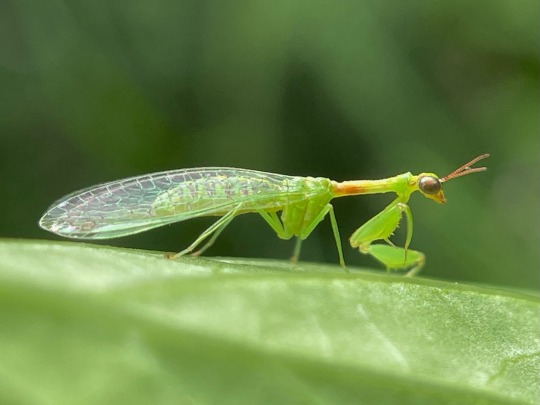
I found an insect last week I’ve wanted to see for as long as I’ve known they existed: a mantisfly! this one is Zeugomantispa minuta, the only species commonly observed where I live.
mantisflies (family Mantispidae) are named for their resemblance to mantises (order Mantodea) but themselves belong to the order Neuroptera, being related to lacewings and antlions. as adults, they closely resemble mantises, and live a similar lifestyle capturing prey with raptorial forelegs.
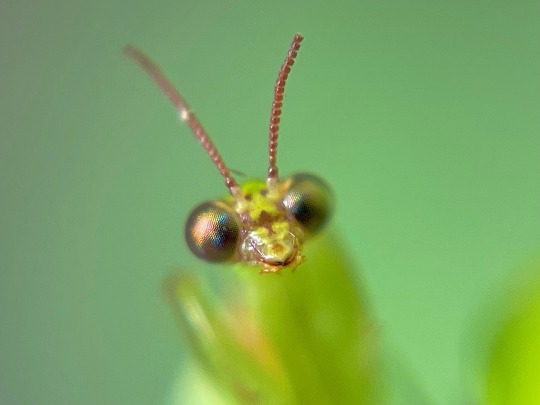
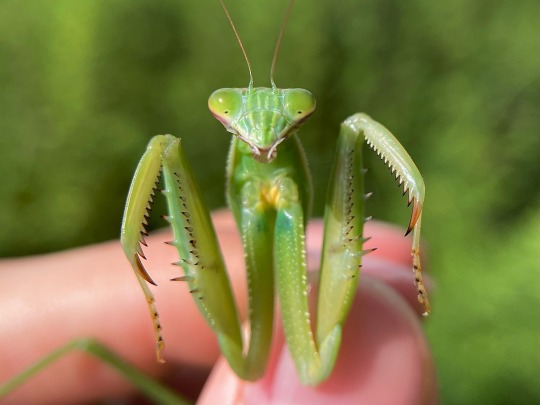
compared to this Chinese mantis (Tenodera sinensis), there are a few anatomical differences you might notice, but the biggest difference between the two is definitely their reproductive strategy.
mantises lay egg cases and develop from nymphs that resemble adults. being neuropterans, mantispid juvenile are larvae. but mantispid larvae, unlike their lacewing and antlion relatives, aren’t predators, they’re parasites! Zeugomantispa follow the strategy of starting as a leggy, highly active larva that on hatching immediately seeks out a spider egg sac to burrow into, growing into a plump grub quite different from its original appearance after feeding on the eggs. other mantispid larvae attach themselves to the adult spiders, and wait for their host to produce a sac; still others parasitize beetle or wasp larvae.
here’s a great photo of a mass of Z. minuta eggs hatching into their sac-seeking first instars!
1K notes
·
View notes
Note
Imagine Peter B keep having to keep Maday away from outside bugs because she keeps trying to eat them. Hobie’s like “nah, let the kid eat bugs, got a lot of protein” but then also sides with Peter after learning that outside bugs can carry parasites dangerous parasites and doesn’t want the little anarchist to get a mind controlling parasite.
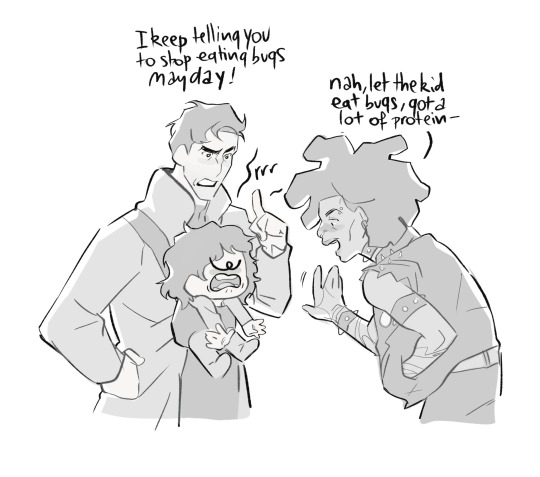



First of all THIS IS SO CUTE! Hobbie being such a caring person, he would be helping Peter no matter what to prevent bad things to Mayday.
I also literally read that high and thought of the fact, that there is a kind of wasp that actually mind control, (thru eggs/ parasite if I’m not mistaken?) to built the perfect nest for them? Like with their spider web?
Anyway, I was into the drawing and it was too late and I’m not even sure it’s a good idea but here it is and thank you for this cute thought!
#ask#fanart#artists on tumblr#across the spiderverse#atsv#miguel o'hara#peter b parker#spiderman across the spiderverse#hobbie brown#mayday parker
545 notes
·
View notes
Note
Ok but like the eggs--
I need to know if they grow!!!
Since there's so many are we under the assumption that reader will have hundreds of little babies? Maybe they fight in the womb (like some shark pups do)
I really hope reader has more than 1 baby since they're multiple little eggs and not just 1
OMG I'm so flattered you ask. I have a lot of headcannons and stuff for it, too! I will preface by saying this is OG headcannons and science, so I'm not abiding by any comics or real-life spider logic, haha.
Warning: sex talk/oviposition/pregnancy talk under the cut. My Miguel has eggs he dumps in you, be aware before clicking read more.
× ×
Okay, so, for Miguel, the eggs are stored in an additional pouch in his abdomen that connects via its own tube to his urethra. The eggs themselves are small, no bigger than a tapioca pearl, and cause no discomfort passing for him. That being said, he generates over one thousand in the span of 4 months. When that pouch gets overfull, it bloats and causes pain and discomfort for him.
When he passes them into reader, his precum/cum itself has a light numbing affect, which causes the cervix opening to relax. The eggs pour out right towards the end of his release, and they naturally gravitate into the cervix.
Once inside, they stick themselves around the womb in tiny clusters. Now comes the fertilization process, as they begin to draw nutrients from the cervical lining. Unfortunately, due to how many it is a battle of the best, and (good guess by the way!), they end up cannibalizing one another until only a few remain. The number of surviving eggs is dependent on the carrier's body health and the father's egg health.
So most likely, 500 eggs are released, 450 make it inside the womb, and they dwindle off one by one (or they fail to latch) and are dissolved by the mothers body. Most likely, due to the amount of space and nutrients needed, only 3 to 5 can survive and fit inside the womb.
After that process, they are generally the size of a golfball and will continue to grow. The casing of the egg breaks once the child is about three months (the babies absorb the egg casing!), and from there, they develop like normal human children.
That being said, the mother would most likely experience terrible side affects as the foreign DNA feeds on her body - the babies, before breaching their eggs, are basically extreme parasites - and it is difficult for mom to go through. But that'd be a whole other post for me to do haha.
Birthing is the same as a human, though with super babies, there will most likely be complications and dangers. Otherwise, yeah! That's how I think it goes. I also agree that the likelihood of having "just one" is small, and you'd definitely have a couple... which Miguel would love. He's always wanted a big family.
#miguel o'hara headcanons#miguel o'hara x you#miguel o'hara smut#miguel o'hara x reader#miguel o'hara#miguel spiderman#atsv miguel#across the spiderverse#spiderman 2099#spiderman across the spiderverse#spiderman x reader#spiderman atsv#spider man x reader#spider man: across the spider verse
894 notes
·
View notes
Text

Parasitic Wasp. But which one? (spoiler alert, someone already identified this as Acrotaphus wiltii). I suspect this is an ichneumonid. But which one? We know little about the identity of this group despite the fact that there are over 700 species of ichneumonids known from the tiny tiny state of Maryland. This particular specimen came from Beltsville Agriculture Research Center. As a group these non-stinging wasps lay their eggs in or on other insects (another spoiler alert - orb spiders) ...almost always their larvae (another spoiler alert. adult spiders in this case). They are picky about their food/hosts and craft clever strategies to find and deposit their baby aliens. The host group, of course, is not into this and develops countermeasures and they both go down paths of more and more nuanced life together, by no measure a marriage, but more of a insecticidal détente where a certain proportion of the host's babies are given up to the wasp, and the wasp doesn't parasitize all the host babies....because if they did its end of the line for them being so specialized and their lives so intertwined such so (note: never use of the word "so" this much) that the wasp must, in a way, support the life of its host all the while letting its children eat some of them alive (spoiler alert, like I said in this case its all about adult spiders) . There is a lesson here for us humans...but it escapes me what that lesson is (other than not useing "so" so often and not over generalizing about ichneumons (they hate that)).
39 notes
·
View notes
Note
What is your favorite worm. What's your favorite crustacean. What's your favorite true bug. What's your favorite parasite. What's your favorite non-true bug insect?
Oh gosh you're asking all the wrong questions-- I'm a herpetologist, and I've never really been particularly interested in anything without a spine. Nevertheless, I shall try to answer to the best of my ability.
Favorite worm: Giant tube worms, because they live near volcanic vents and basically live off the sulfer, which is crazy!

2. Favorite crustaceans: Japanese spider crabs; when I was a kid I could spend ages watching them at the Shedd Aquarium. I love their long legs!
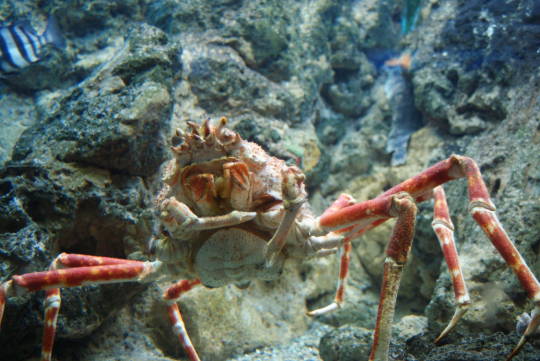
3. Favorite true bug: Annual cicadas, because I always associate them with summer (although stepping on their old shells was. unpleasant.)

4. Favorite parasite: Parasitoid wasps; I think their method of parasitism (laying their eggs in or on other arthropods) is really neat!
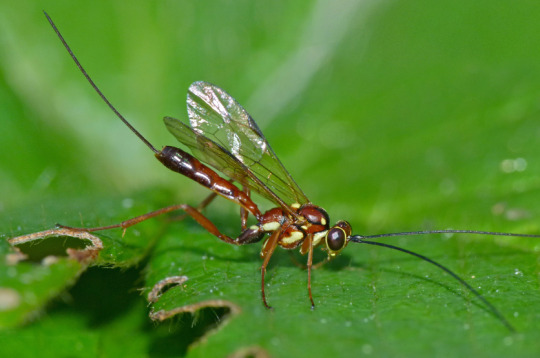
5. Favorite non-true bug insect (not a fair question imo, considering how many species are included): Probably fireflies, again because I associate them with summer-- when I was a kid I'd see how many I could catch before it got too dark.

And there you have it! I'll admit some of these were easier to answer than others; as I said, inverts are not my specialty by any means. But this was a lot of fun to answer, even if I did have to look up a few things!
67 notes
·
View notes
Text

I forgot to show you all this cool wasp I found when I was hiking in old growth forest in Missouri last month! She's an Atanycolus species, probably A. cappaerti, and she's a native stingless wasp found primarily in the eastern half of the United States. You can tell she's stingless because she has a long, skinny ovipositor at the end of her abdomen instead of a shorter, sharper stinger.
In fact, stingers are just modified ovipositors found in some members of the order Hymenoptera (wasps, bees, ants, sawflies). Originally the structure evolved so that the female could inject her egg into a safe place, whether that was a leaf or stem of a plant, or a hapless insect or spider host. But some species changed it through evolution so that it not only could more easily penetrate the skin or exoskeleton of an attacker, but inject venom as well. This not only allows some parasitic wasps to more effectively subdue and paralyze their hosts, but defend themselves and their nests as well.
A. cappaerti has a variety of insect hosts, but I was delighted to hear that this species will readily parasitize larvae of the invasive emerald ash borer (Agrilus planipennis). And even better news--there are other native wasps that also use the ash borer as a host! All of which means these native wasps could be used for intentional biocontrol of the invasive insects without having to bring in non-native parasitic wasps.
#wasps#wasp#insects#bugs#Hymenoptera#stingless wasps#animals#wildlife#nature#native species#invasive species#emerald ash borer#ecology#conservation#invertebrates#arthropods#Missouri#Ozarks
28 notes
·
View notes
Text
In the “I berried him six feet deep” scene(book) Kaz really reminds me of a cuckoo bird.
If you don’t know what a cuckoo bird is, it’s alright, I’ll gladly explain it.
Cuckoo birds are famous for throwing their chicks into the nests of other birds. Their eggs don’t look suspicious for a mama bird, but as a cuckoo bird gets older it starts demanding more food, and eventually throws the ‘true’ chicks that cannot yet fly out of the nest. In the end the mama bird is left with a ‘parasite’ which she continues to feed because views it as her child.(forgot to add, cuckoo birds are HUGE, and even chicks are bigger than a mama bird)
Also in the Eastern Europe where cuckoo’s mostly live exists a believe that if you ask cuckoo birds “cuckoo, how long do I have to live?” the amount of ‘cuckoo’s that you’ll get is the number of years you have left.
Reminds you of anyone?
Kaz got to Ketterdam as a sweet little boy who was no threat to anyone. But after Jodie’s death he became the ‘parasite’.
Kaz gets rid of most barrel gangs step by step, brick by brick, until eventually he’s left one on one with Pekka.
He feeds himself on Pekka’s empire by stealing his ‘pigeons’ and slowly, almost unnoticed, draining his clientele and money.
Inej also has ‘cuckoo’ vibes:
As soon as she gets out of the “menagerie” she gives Kaz an opportunity to stop using Tante Heleen and ‘her girls’ as a blackmail source.
She basically feeds herself on the money Tante Heleen would have had if Kaz didn’t get Inej as his spider.
In the end she’s basically the reason why Kaz destroys “Menagerie”
#kanej the cuckoo couple#six of crows#kaz brekker#grishaverse#crooked kingdom#inej ghafa#kaz rietveld#kaz six of crows#kaz x inej#kazzle dazzle#kaz being kaz#kaz speaks#*cries in kanej*#kanej#kanej supremacy#kaz is a simp#kaz and inej#inej x kaz#soc inej#six of crows inej#sankta inej#inej my beloved#inej supremacy#inej#kanej aesthetic#kanej has my whole heart#kanejdaily#the grisha series#grishaverse analisis#the grishaverse
117 notes
·
View notes
Note
Hello! I am sorry to bother you. I really love your comic Bugtopia (and Monsters and Girls) I have a few questions, if you don't mind.
I believe you have talked about how bugs are especially prejudiced/scared for spiders because the idea of getting caught in a web is such a scary thing. So I wonder how are parasitoid bugs seen? Are some of them seen as "worse" than spiders? Are parasites "the same" in your wonderful Bugtopia like in the real world? Like the eating of other bugs in particular? Like does the "Large blue" pretend to be a larval queen ant (and eats the other ant larvae)?
Do the many parasitoid wasps, well, do what they do? (Don't google that unless you're ready for some truly gorey stuff.) While I get the "caught in a web" fear, I think parasitoid wasps behavaiour are scarier than that and wondered what your thoughts are on that?
Sorry for asking so many questions.
I hope you have a great day!
Not a bother don't worry!
Many bugs are extremely wary of parasitoid bugs due to their tendency to eat fellow bugs or lay eggs in unsuspecting bugs, some locations even banning them from entering shops and markets.
Parasitoid Wasps do what you would expect, but i also like using them metaphorically too. Parasitoid Wasps can be very clingy and controlling, and can even use their abilities to threaten other bugs
69 notes
·
View notes
Text
random athf hcs
i know characters dying but reviving next ep/no continuity is the norm, but when it comes to steve, it would not surprise me if dr. weird had a large collection of steve clones that he just goes through for the lulz. he never has to hire new peeps so it's just convientient
plutonians purr like cats do and for the same reasons, but the purr sounds like a combo of a cat, a dove's coo, and a gutteral rattle
Carl: 6', Frylock: 5'3", Shake: From bottom to cup lid 5' but to the bend of the straw it's 6', Meatwad: 2', Oglethorpe: 5'9", Emory: 7', Ignigknot: 3', Err: 1', MC Peepants (Big Spider Mode): 8', Dr. Weird: 6'6", Steve: 5'9" for some heights
shake's pistachio milkshake power works like snake venom in that he can only shoot out a certain amount of it until he empties out, and that it takes a lot of energy/nutrients to regenerate it. not that it changes anything bc he'd still be a depraved omnivore of a sentient milkshake w/o the setback but uh. OH yea and it is edible, enough to fill a route 44 from sonic to the top, but you'd have to ask REAL nice or be hyper sweet to him if you wanna get it but no guarantee. plus hed prolly spit in it or immediately toss it to the ground
frylock's fries are also edible but it genuinely hurts him if you eat it bc while it is sorta like his hair, some also have bones in them and are basically like our hands/arms. maybe if he shoots his fries at you like in the movie it would be ok, but you'd get hurt af and it's the same w shake in that he cant use it too much bc it takes a lot of biological resources & energy to regenerate. if he wants to cut his hair he can take certain pain mediation for it.
DO NOT EAT MEATWAD. 1.) if u do ur a monster but 2.) it may be ground meat but it's got garbage, sand, broken down bits of food, dirt, poop?, pee, parasites, the whole 9 yards so unless ur a animal or if you want to shit ur organs and skeleton out bc ur that desperately hungry then go ahead ig
meatwad works through slime logic in that he can't actually die unless hes been atomized/obliterated completely/eaten whole then yea hes dead. he just needed some time to recuperate dw abt it. not to mention he can also eat just abt anything in any amt. also he knows every aspect of the skibidi toilet lore, but only some major details on the fnaf lore but do NOT ask him abt reminant and fazgoo cuz he'll just stare at you blankly
the mooninites used neil armstrong's footprints on the moon as their restroom
carl doesn't know what an anime is but if he did knew what it was he would absolutely be a fan of it (even if he'd hide it in shame). you dont wanna know what else.
shake sucks at sports in general and anything that requires physical activity, he prefers to watch it on his seat instead. he is physically strong when he's prepared to fight, but if you catch him by surprise he's a complete bitch. actually hes a complete wuss in general when it comes to trying to fight anyone bigger/aggressive than himself. if him and his girl get mugged while walking in the middle of the night he's tossing her at the robber and running (jumping) away. but anyone weaker/smaller/meeker is fair game bc ofc
frylock has misophonia (hates the sound of people chewing). anytime he tries to explain it, shake makes a mesothelioma joke. but also it's so intense he will straight up blast you if you dont listen to him, shake had to learn that the hard way
mooninites can only comprehend music in 8 bit/midi. like ignignokt can listen to regular classic rock and be like "fuck yea bro" but through his ears(? head??) it sounds like an 8 bit/midi rendition of it. idk if this is making any sense but the closest i can come up w is that its more like a translation thing
plutonians do poop/excrete?? waste that does act like all purpose cleaner from earth but it smells highkey like rotting eggs and aged cheese, maybe even worse depending on what they've ate
#headcanons#text post#athf#the mooninites#frylock#meatwad#master shake#carl#the plutonians#i dont wanna tag all the chars#i think too much abt this shit dtrfghf#way too damn serious for a show like this lmaooooo
33 notes
·
View notes
Text
Round 1 - Phylum Arthropoda
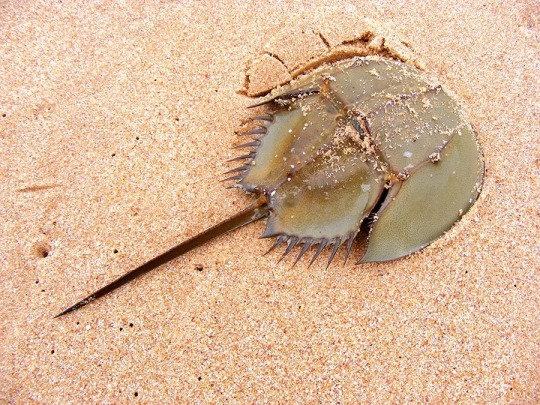



(Sources - 1, 2, 3, 4)
Arthropoda is a phylum of animals that have segmented bodies, possess a chitin exoskeleton, and have paired segmented appendages. They are colloquially called “bugs” though this is often only used for terrestrial arthropods, and sometimes only used for insects specifically.
After Nematoda, this is the most successful phylum, and it is far more diverse, with up to 10 million species! Arthropods account for 80% of all known living animal species. The three major subphyla include the Chelicerates (sea spiders, horseshoe crabs, arachnids, and the extinct eurypterids and chasmataspidids), the Myriapods (centipedes and millipedes), and the Crustaceans (shrimps, prawns, crabs, lobsters, crayfish, seed shrimp, branchiopods, fish lice, krill, remipedes, isopods, barnacles, copepods, opossum shrimps, amphipods, mantis shrimp, entognaths, and insects).
Arthropods are so diverse in fact that it is next to impossible for me to describe a model arthropod. They are important members of marine, freshwater, land, and air ecosystems and are one of only two major animal groups that have adapted to life in dry environments, the others being chordates. All arthropods have an exoskeleton and must molt as they grow, replacing their exoskeleton. Some arthropods go through a metamorphosis in this process. They have brains, a heart, and blood (called hemolymph, though some crustaceans and insects also use hemoglobin). They sense the world through small hairs called setae which are sensitive to vibration, air currents, and even chemicles in the air or water. Pressure sensors function similarly to eardrums. Antennae monitor humidity, moisture, temperature, sound, smell, and/or taste, depending on species. Most arthropods have sophisticated visual systems ranging from simple eyes (ocelli) which orient towards light, to compound eyes consisting of fifteen to several thousand independent ommatidia capable of forming images, detecting fast movement, or even seeing polarized or ultra-violet light. Some arthropods are hermaphroditic, some have more than two sexes, some reproduce by parthenogenesis, some by internal fertilization, some by external, some have complex courtship rituals, some lay eggs, some give live birth, some have prolonged maternal care. The first arthropods are known from the Ediacaran, before the Cambrian era.
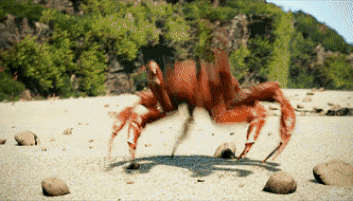
Propaganda below the cut:
Insects are the first animals to have achieved flight
The smallest arthropods are the parasitic crustaceans of the class Tantulocarida, some of which are less than 100 micrometres long. The largest arthropod is the Japanese Spider Crab (Macrocheira kaempferi) with a legspan of up to 4 metres (13 ft) long. The heaviest is the American Lobster (Homarus americanus), which can get up to 20 kilograms (44 lb).
Many arthropods are popular pets, including various species of crab, shrimp, isopod, crayfish, mantis shrimp, millipede, centipede, tarantula, true spider, scorpion, amblypygid, vinegaroon, mantis, cockroach, beetle, moth, and ant! Some are even domesticated, including silk moths and honeybees.
Many arthropods are eaten by humans as a delicacy, and farming insects for food is considered more sustainable than farming large chordates. These farmed arthropods are referred to as “minilivestock.”
Arthropods feature in a variety of ways in biomimicry: humans imitating elements of nature. For example, the cooling system of termite mounds has been imitated in architecture, and the internal structure of the dactyl clubs of mantis shrimp have been imitated to create more damage tolerant materials.
Spider venoms are being studied as a less harmful alternative to chemical pesticides, as they are deadly to insects but the great majority are harmless to vertebrates. They have also been studied and could have uses in treating cardiac arrhythmia, muscular dystrophy, glioma, Alzheimer's disease, strokes, and erectile dysfunction.
Shellac is a resin secreted by the female Lac Bug (Kerria lacca) on trees in the forests of India and Thailand. It is used as a brush-on colorant, food glaze, natural primer, sanding sealant, tannin-blocker, odour-blocker, stain, and high-gloss varnish. It was once used in electrical applications as an insulator, and was used to make phonograph and gramophone records until it was replaced by vinyl.
One of the biggest ecosystem services arthropods provide for humans is pollination. Crops where pollinator insects are essential include brazil nuts, cocoa beans, and fruits including kiwi, melons, and pumpkins. Crops where pollinator insects provide 40-90% of pollination include avocados, nuts like cashews and almonds, and fruits like apples, apricots, blueberries, cherries, mangoes, peaches, plums, pears, and raspberries. In crops where pollinators are not essential they still increase production and yield. Important pollinators include bees, flies, wasps, butterflies, and moths.
Many arthropods are sacred to humans. In Ancient Egypt, scarab beetles were used in art, religious ceremonies, and funerary practices, and were represented by the god Khepri. Bees supposedly grew from the tears of the sun god Ra, spilled across the desert sand. The goddess of healing venomous bites and stings, Serket, was depicted as a scorpion. Kalahari Desert's San People tell of a legendary hero, Mantis, who asked a bee to guide him to find the purpose of life. When the bee became weary from their search, he left the mantis on a floating flower, and planted a seed within him before passing from his exhaustion. The first human was born from this seed. In Akan folklore, the cunning trickster figure Anansi/Ananse is depicted as a spider. Western astrology uses the crab constellation, called Cancer, and the scorpion constellation, called Scorpio. Dragonflies symbolize pure water in Navajo tradition. In Anishinaabe culture, dreamcatchers are meant to represent spiderwebs and are used as a protective charm for infants. They originate from the Spider Grandmother, who takes care of the children and the people of the land in many Native American cultures. The Moche people of ancient Peru often depicted spiders and crabs in their art. In an Ancient Greek hymn, Eos, the goddess of the dawn, requests of Zeus to let her lover Tithonus live forever as an immortal. Tithonus became immortal, but not ageless, and eventually became so small, old, and shriveled that he turned into the first cicada. Another hymn sings of the Thriae, a trinity of Aegean bee nymphs. Native Athenians wore golden grasshopper brooches to symbolize that they were of pure, Athenian lineage. In an Ancient Sumerian poem, a fly helps the goddess Inanna when her husband Dumuzid is being chased by galla demons. In Japanese culture, butterflies carry many meanings, from being the souls of humans to symbols of youth to guides into the afterlife. Ancient Romans also believed that butterflies were the souls of the dead. Some of the Nagas of Manipur claim ancestry from a butterfly. Many cultures use the butterfly as a symbol of rebirth. And the list goes on…
cute crab eat a strawbebby:
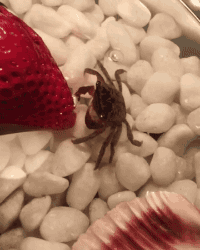
#round 1#animal polls#listen narrowing it down to just 4 images almost killed me#if arthropods don’t move on to round 2 I will have to take like an extra week off to mourn that I can’t show you all the cool bugs#there’s so many cool bugs guys#i chose the orchid mantis over a trilobite beetle and a poofy little bee fly cause I figured it had broader appeal#and used a horseshoe crab instead of a spider cause people are so Weird about spiders I worried it would impact the numbers#sigh#anyway I’m really hoping for Chordata Arthropoda Mollusca as top three#other phyla are all great but these three would make for the most interesting Round 2 imo#arthropoda
241 notes
·
View notes